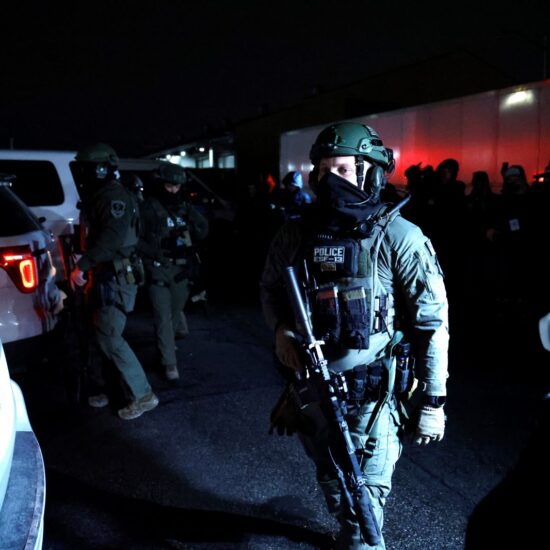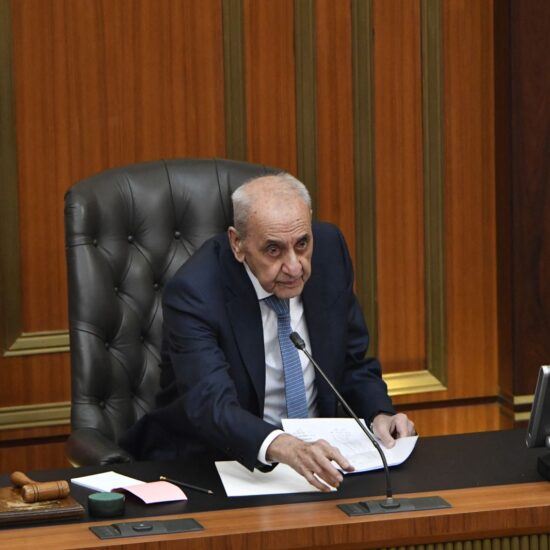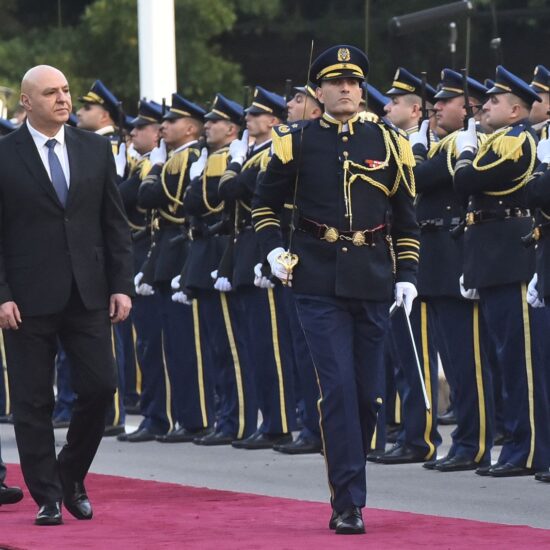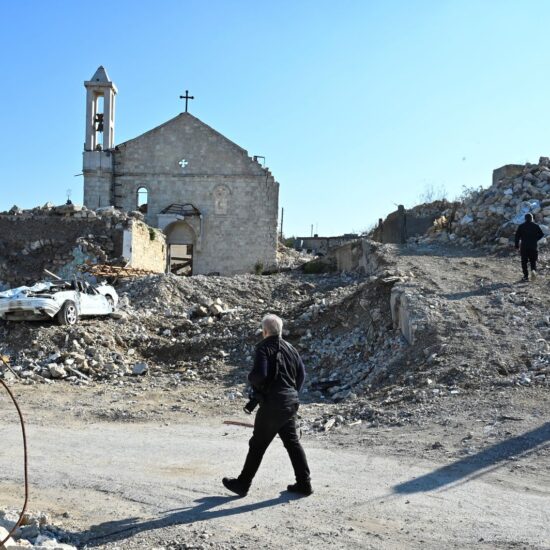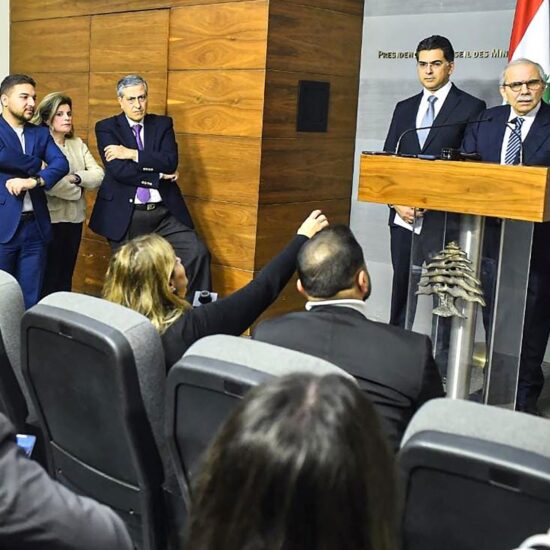
As Syrian refugees fleeing the escalating conflict in Lebanon are denied access to the majority of shelters in the country, doubly-displaced are left with little options: sleeping in the streets, as winter approaches; taking the dangerous sea road, often facing rejection by Western sea authorities; or going back to Syria, a country torn by 13 years of another, devastating war. Already facing a hostile climate of xenophobic hatred against them in Lebanon, for 1.5 million people, nowhere is a safe place
When, on Monday, October 14, Russian warplanes bombed towns and villages in opposition-held northwestern Syria – and again on Tuesday, for the second day running, injuring dozens of people and damaging an electrical power plant, and on Wednesday, killing 11, including a child – the relative calm in the country’s north-western region collapsed again, after a ceasefire – despite fragile – was laboriously, yet volatilely achieved between the regime and the anti-Assad forces in March 2020. And the illusion of a safe place for the hundreds of thousands of Syrian refugees in Lebanon, fleeing the escalating war against Israel towards their country of origin, proved to be a lie. Yet another one.
Between the beginning of the latest Israeli escalation of violence against the country, the launching of the operation ‘Northern Arrows’ on September 23, and last Tuesday, October 22, according to the latest figures provided by the Lebanese authorities, 343,404 Syrian citizens and 147,608 Lebanese citizens crossed into Syrian territory.
In the first days of the massive displacement, people fleeing to Syria from south Lebanon, the Beqaa Valley and the southern suburbs of Beirut, encountered a first obstacle at the border: those who had Syrian citizenship were required to pay 100 dollars as an entry visa. A fee that was not asked to the displaced carrying a Lebanese ID, Syrian journalist Lamis Abou Assaf confirms. Originally from Suwaida, in the south-west of the country, she’s been living in Lebanon since the Assad regime forced her to leave, several years ago.
“Today I turned my eyes on Facebook posts all welcoming the Lebanese brothers,” she posted on September 25, at the beginning of the mass displacement of more than 2 million people, 460 thousands of whom in total found refuge in Syria. “It’s not a mistake. What is wrong is that my ‘dear’ country is stopping thousands of displaced Syrians on the border asking them to pay the 100 dollars, which, for a family of five members, means 500 dollars. From where do they expect the displaced Syrians would take the money? It might be too late. They can’t find their home. Indeed, Syria, as a country, has become a mockery, and surely not for its people.”
Furthermore, those trying to pass through the official border posts – with enough money to ensure the crossing – have mainly been women, children and the elderly, because for men in conscription-age the risk of arrest or of being considered draft dodgers was, and still is, very high.
Even though on September 22, coinciding with the eve of the launch of the Israeli assault on Lebanon, Syria’s President Bashar al-Assad issued his government’s promise of amnesty to political prisoners and men of conscription age who have avoided forced military service, many know that this promise, made to encourage Syrians to return a country that is no longer home, is not what it seems to be.
“It is the twenty-fourth time this has happened,” explains journalist Ahmad Alqusair, originally from the district he carries the name of, in the governorate of Homs, reporter for Syria TV, who has been covering the war in south Lebanon, live, under the constant threat of Israeli bombardments. “In reality, the Syrian regime is detaining returnees, it has been doing so each of the twenty-three times before this, it will not stop now. Exhaustive documentation carried out by humanitarian organisations and local media reported several cases of detention in the past weeks.”
The Syrian Network for Human Rights (SNHR), in this regard, documented the arrest of at least nine Syrians by the Assad regime as they fled the escalating Israeli raids on Lebanon that have been ongoing since September 23. The organisation revealed in its September’s report that “no fewer than 206 cases of arbitrary arrests were documented in September 2024, with those detained including nine children and 17 women. The group also noted that the Syrian regime has arrested nine refugees who returned from Lebanon amid the Israeli offensive.” The nine individuals, most of them from the rural Damascus governorate, were arrested at the border crossings with Lebanon under the pretext of failing to comply with the regime’s conscription policies. They were taken to security and military detention centres in Homs and the capital’s governorates. At the moment, there are at least 17 cases confirmed throughout the country, said Fadel Abdulghany, executive director of SNHR, proving that Assad’s promise of an amnesty is, again, a weak and unconvincing strategy to whitewash his brutal oppression towards political opponents, conscientious objectors, or those who have left the country for economic reasons.
On the same line of Alqusair, writing for Al Jazeera, President of the Syrian National Coalition Hadi al-Bahra stated that “Al-Assad utilises these decrees as a means to deceive the international community that he is making an effort towards stability and reconciliation. But a close examination of these decrees reveals that they leave considerable room for security agencies to manipulate the fates of individuals who are purportedly covered by the amnesty.” While the decrees specify amnesty for certain offences, in fact, charges levelled by the regime against political opponents, such as ‘terrorism’ and ‘high treason’, remain excluded, al-Bahra explained. “This effectively means that the majority of political detainees and activists remain outside the scope of these decrees, rendering them ineffective in providing a safe environment for the return of refugees.”
No place is safe
In an interview with Syria TV, director Abdulghany stated that, in addition to the 17 confirmed cases, verified by SNHR, information regarding dozens of others is circulating. The network is still verifying these cases, which mostly occurred at temporary checkpoints set up by regime forces along the returnees’ routes or after individuals were summoned from shelter centres for a so-called ‘settlement.’
Meanwhile, the Suwayda 24 Network reported that families of four young men faced the same destiny – two having evaded compulsory military service, and working in Lebanon to make a living; the other two having joined the peaceful uprisings, thus labelled as political opponents. In one of its latest reports, the media outlet quoted the families of three of the detained young men, who said they were arrested at a military intelligence checkpoint in al-Jadida, in the Damascus countryside, after midnight.
Once having entered the country – which, it is worth repeating, is the last option of negotiated safety for many Syrians fleeing Israeli bombs, racial discrimination, and rejections at Cypriot waters, after taking the deadly sea route – many are afraid to remain in the areas under the control of the regime. Therefore, some head towards the Kurdish north-east, the AANES (Autonomous Administration of North and East Syria), which is welcoming, according to the Administration’s Crisis Cell, nearly 20,000 people – among whom only 69 of Lebanese nationality – in several shelters, including the Social Welfare Center in Raqqa, which was previously concerned with organising returns from al-Hol, a detention camp holding the families of Islamic State (IS) members. However, while the fear of conscription or detention is particularly acute in regime-controlled areas, military-aged men and women in AANES territory also face conscription into what is known as ‘self-defence duty,’ a 12-month mandatory service for males and females who have completed 18 years of age. A requirement for people from its areas, that falls also any residents who have lived there for at least five years. A completely reasonable time of displacement and resettlement, if we consider that, once the ceasefire is reached – which still seems like a mirage – it will take years to rebuild southern Lebanon and the Beqaa valley: not to mention that it is not said that Syrians will be allowed to return to the host country, assuming they’ll want so.
Nevertheless, the autonomous north-east is often only a transit area towards the north-west held by the anti-Assad forces: some areas under Turkish control, and others under that of Hayat Tahrir Sham (HTS). On October 9, in fact, the first groups of Syrian refugee families who previously smuggled through areas controlled by Assad, began crossing into north-western areas from the north-east, marking yet another chapter in their ongoing cycle of displacement. To do so, however, thousands of migrants – in the etymological, non-pejorative sense of the word: they migrate, in search of salvation, and paradoxically, towards their own disastrous origins – have relied on traffickers to cross the border and return to the country from which they had to flee and which now appears to be the lesser evil.
Testimonies report that a journey from Lebanon to the north-west of Syria, surprisingly across the official borders – mainly the Maasna one, which was targeted by Israeli airstrikes earlier this month, and again on the night between October 21 and 22, cutting off the road in both directions, following claims over the past week that Hezbollah is using it to smuggle weapons – can take up to seven days, during which smuggled families have to pass through Damascus, Homs and Hama, eventually reaching the Aleppo countryside in a truck via agricultural roads free of regime checkpoints. From there, through the Fourth Division checkpoint, an élite formation of the Syrian Army, to the humanitarian crossing between the areas controlled by the Turkish-backed Syrian National Army, in the north-west, and those controlled by the Syrian Democratic Forces, a Kurdish-led coalition formed by ethnic militias and rebel groups, in the north-east. Without borders and checkpoints, the same trip would take less than five hours.
Another one of the official escape routes from Lebanon to Syria – the Joussieh border crossing, connecting the north of Lebanon to Homs – was also targeted by an Israeli airstrike on the morning of Friday, October 25, on the Syrian side, just a few metres away from the UNHCR hub hall, used to provide assistance to hundreds of Syrians and Lebanese arriving after a long and dangerous journey, every day.
Despite the danger, according to the Syrian Civil Defence – also known as the White Helmets – about 1,700 civilians fleeing the war in Lebanon have now arrived in areas of north-western Syria controlled by the opposition forces. Neither there, however, the first exiled, then refugees, and now returnees – escaping from an ongoing death – are safe.
From death to death
According to the Syrian Observatory for Human Rights (SOHR), based in London, the number of Syrian refugees killed in Lebanon as a result of the ongoing and intense Israeli escalation on Lebanese territory since September 23 has now reached 176, including 33 women and 46 children. Yet, also in Syria, despite surviving the grips of the Assad regime, after passing several checkpoints, paying countless smugglers, people continue to die.
On Monday, October 14, Russian warplanes carried out 25 airstrikes targeting suburbs of Idlib city as well as parts of southern and western Idlib province. The day after, six Russian Sukhoi-24 and Sukhoi-34 planes carried out 11 other strikes, targeting opposition-held areas of Latakia, Idlib, and Hama provinces, while drones flew overhead. Again, on Wednesday, October 16, Russian fighter jets carried out 28 airstrikes on the same areas, targeting civil and military areas in Idlib countryside and the Telal Kabana Hills in northern Latakia countryside. Syrian pro-regime media said that the strikes were a ‘warning’ to Syrian opposition forces, amid reports that the opposition was preparing to attack regime forces in northern Syria.
There has been speculation that opposition forces, without the Turkish green light, were allegedly planning to attack regime forces in western Aleppo and in eastern and southern Idlib – areas in which Lebanese Hezbollah forces are stationed – in order to try and take advantage of the setbacks the Iran-backed ‘Party of God’, a key regime ally, has suffered in Lebanon, with Israel eliminating most of its top leadership. On the other side, the Syrian Observatory for Human Rights stated that regime forces have deployed reinforcements from the 25th Special Forces Division, the Fifth Corps, and the Republican Guard to the front lines in the western countryside of Aleppo. The arrival of dozens of four-wheel-drive vehicles mounted with heavy machine guns, 75-pound cannons, rocket launchers, closed military trucks, and several tanks transported on flatbeds, was as well documented by military media correspondents affiliated with regime forces, leaving little room for doubts about the opening of yet another dangerous warfront.
Beyond the strategic reasons, however, from the perspective of hundreds of thousands of people fleeing one war to another, this is nothing more than a mere exchange of bombardments: escaping from one death, in the country that so reluctantly hosted them, to another, in their own, which forced them out, with all means possible.
From discrimination to discrimination
Despite the widespread hospitality offered by the Syrian population, as Lamis wrote in her Facebook post – and as she confirmes, during our meeting in Beirut, with the uninterrupted buzz of drones above our heads – in reality there is news of shelters set up by the regime which do not they accept Syrians, but only Lebanese, and the few Palestinians who crossed the borders – while the majority of them, even Palestinian-Syrians who were massively displaced to Lebanon after 2012, prefer to find shelter in ‘safer’ Palestinian refugee camps in the north of the country.
“The regime is establishing shelters in Syrian schools,” Lamis says, “but they only accept Lebanese refugees.” Just as it is happening inside Lebanon. And to my questions about the non-governmental organisations operating in the country, like UNHCR, Ahmad replies: “Every NGO which is able to operate inside regime-held areas, is under Bashar al-Assad’s diktat. It has been like this already for four or five years.”
In addition, the journalists’ accounts tally with those of other displaced people in Syria who claim that landlords are hiking rents to take advantage of their predicament. Several press reports have documented an unprecedented surge in rental prices in Damascus, with increases exceeding 60 percent in some areas, like Mezzeh and Kafr Sousa, where annual rents for an apartment have reached more than 180 million Syrian pounds, equivalent to over 12,000 US dollars – while many landlords are giving tenants the choice between immediate rent increases or vacating their homes, as it is happening in several areas of Lebanon, especially in Beirut.
Despite not seeming surprised by the expected move of high demand amid tragic conditions, Ahmad stresses how those who fled Syria after 2011, and are now fleeing Lebanon – where they were denied the right to work, apart for few exceptions: namely construction, cleaning or agriculture – are most of the time people with little money, and very numerous families. Even for residents in Damascus, affording these soaring rents became almost impossible, as they were already struggling to cope with the high cost of living due to significantly declining wages.
In the midst of all of this grief, it is worth reminding how much racism and contempt the one and a half million Syrians who have lived in Lebanon have had to face in recent years; recounting how during the Israeli attack in 2006 the Syrians instead opened their doors to their Lebanese neighbours – of course, the proportion of numbers was very different and the situation was temporary; how, before 2011, Syria was the country with the most refugees in the world having also welcomed a million Iraqis fleeing the US invasion, and having a large population of Palestinian refugees in due to the Israeli expulsions of 1948 and 1967, who enjoyed, before the civil war, much more rights than their compatriots in Lebanon. And that now, once again, despite the opportunism of some, are opening the doors to dozens of thousands of displaced Lebanese.
It will be enough to report that Ahmad’s family house in Al-Qusayr, Homs – where he was born and he grew up, from where the regime arrested his little brother, and that he was forced to abandon – was first occupied, then destroyed by Hezbollah. His steadfast father built it again: now, he accepted twenty-five Lebanese refugees, no matter their political standings.



